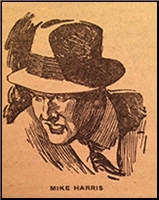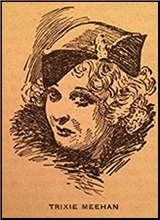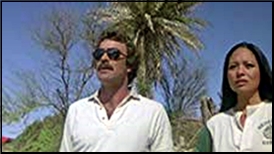REVIEWED BY DAVID VINEYARD:
JOHN CHRISTOPHER – The Little People. Hodder & Stoughton, UK, hardcover, 1967. Simon & Schuster, US, hardcover, 1967. Avon V2243, US, paperback, August 1968. Serialized in three parts in The Magazine of Fantasy & Science Fiction, January through March 1967.

The house lay at the heart of the wilderness. Small creatures moved in the lawns and gardens, fish cruised in the lake. In the house itself, mice came out from holes and wainscots and fed on crumbs, vaguely aware that things were easier, now the cats and the rats had gone. For the rats had gone indeed. They had come to this place a millenium and a half ago, with the first men who settled here. For fifteen centuries, man had waged war on them, and the rats had survived. They had survived the periods of man’s absence, too. Now they were gone, killed not by starvation, or poisons, or traps, but by a new, strange, subtle and deadly weapon, wielded by creatures who still did not know the nature or the extent of their powers; but who were learning. The cats, who had been their hunters, died with them. The mice lived on, undisturbed, because they posed no threat to the new masters.
In their bedrooms, men and women slept, and dreamt their ordinary dreams. Elsewhere in the house, figures, human in form though not in stature, moved silently and quickly. Sometimes they talked to each other, mouthing a guttural tongue in high liquid voices, but speech was a habit, not a necessity. They had long known what it was to share each other’s thoughts, but now they were aware of other minds, of territories open, and vulnerable. This was not like the rats or the cats had been : they had no sense of danger. More from curiosity and interest than malice, they made their forays, conducted their manipulations.
Conveniently John Christopher introduces the title characters of his novel, The Little People, fairly late in the action just as the reader and a few of the cast of eight protagonists gathered at a holiday at Castle Kilabeg in Western Ireland on the Kilabeg bog discover the mystery they have uncovered is more sinister than it origins in Nazi pseudo-science. As is the usual way with Christopher, suspense is ratcheting up to a fever pitch, along with terror, as the something awful at the heart of the action works into the light.

Christopher was one of the leading exponents of a particularly British type of science fiction I think of as British Gothic SF, a genre that begins with H. G. Wells and finds its modern voice in John Wyndham, and which was practiced by writers as diverse as John Creasey, John Blackburn, Christopher Priest, Nigel Kneale, Charles Eric Maine, Christopher Hodder-Williams, Philip McCutchan, L. P. Davies, and at times even John Buchan, Victor Canning, and Geoffrey Household.
Chief among its attributes are usually a modern often bucolic setting, flawed modern protagonists pitted against something beyond their understanding or ability to combat, and a sense that some things may never be fully explained or understood.
Christopher (Sam Youd), who also wrote straight suspense fiction (Scent of Poppies, Caves of Night), historical novels (Sarnia), but made his name with No Blade of Grass (aka The Death of Grass), The Possessed, Pendulum, The Long Winter, and The Ragged Edge (Christopher once remarked in an interview about the number of civilizations he had destroyed) and went on to write the classic juvenile Tripods series, falls somewhere between John Wyndham and J. G. Ballard (I’ve seen it suggested Ballard had read Christopher) in voice and ranks high in his ability to generate real suspense and quiet terror while drawing believable human beings thrown into irrational confrontations. His best books usually feature a group of people in isolation placed under incredible tension as in The White Voyage and A Cloud of Silver.
Here a group of people, a German businessman, son of a Nazi war criminal and his half Jewish wife; a British couple who hate each other and their sexually precocious teen age daughter; the owner of Castle Killabeg, an attractive young woman, who recently inherited it, her London-based solicitor boyfriend and his solicitor pal from Dublin; gather on holiday in sharply drawn portraits replete with flaws and discover there is something going on at the Castle. When one of them sees a perfectly formed human being only a foot tall dressed in green, it seems like an Irish fairy tale come true, but all too soon it becomes clear this is not the wee fairy folk of legend.

Soon enough they discover these small people are substantially real and make contact. They learn that they are the result of Nazi medical experiments to retard human growth and that they and the Nazi who created them were smuggled into neutral Ireland at the end of the war by the owner’s recently passed uncle.
Horrible enough, but there is more, especially when the housekeeper who has shown a morbid fear of them is found dead at the bottom of the cellar stairs, and what happened to the rats that inhabit any Irish castle worthy of the name?
From that point on, the terror ratchets up exponentially as the “little people†play on the fears and weaknesses of the humans in the castle, all building to a night of terror in which humans face their darkest nature and greatest fear manipulated by the little people made monsters by their creator and masters.
Some of you may recall the Avon paperback edition of this novel with a garish cover that makes it look like Ilsa the SS She-Wolf meets whip and Swastika bearing Leprechauns. Glorious as that piece of pulp art might have been it did ill service to a fine suspense novel that deals with something far more serious than pulp exploitation. The Little People is not only a fine read, it has something to say about what makes us human and what makes monsters into monsters, human and inhuman.



